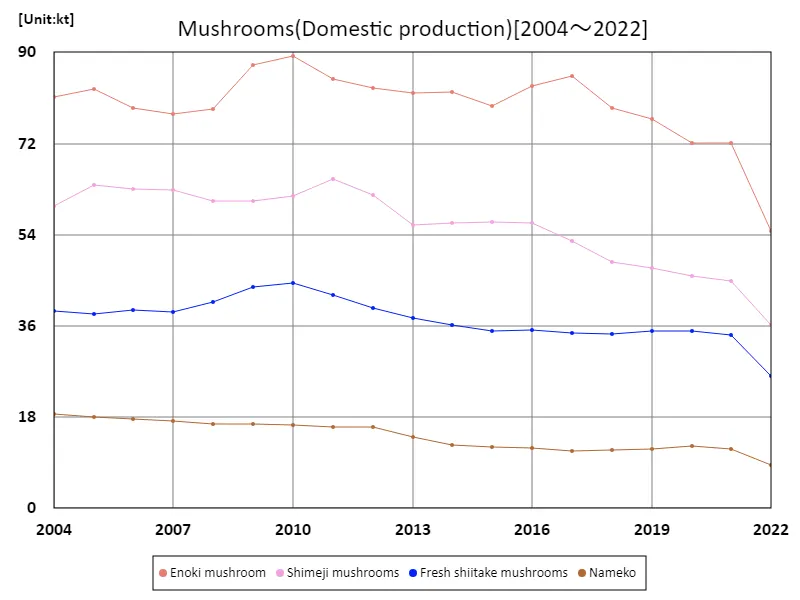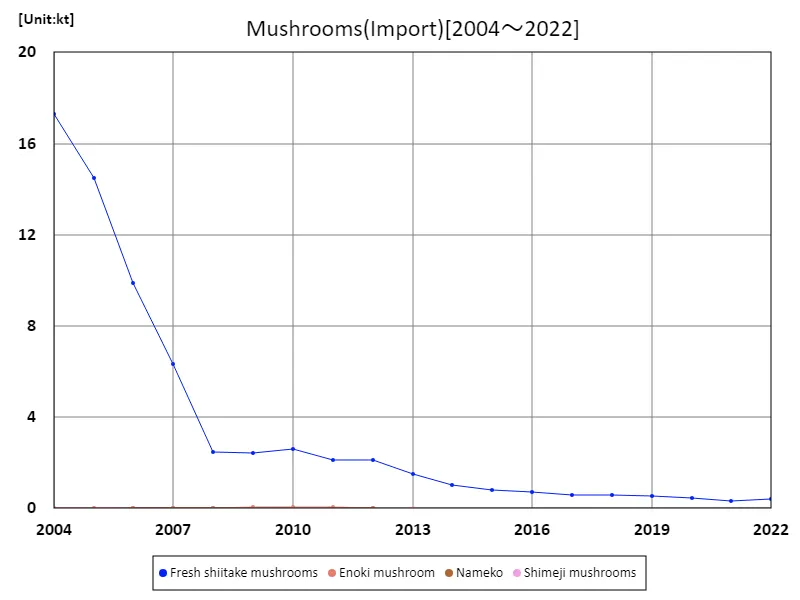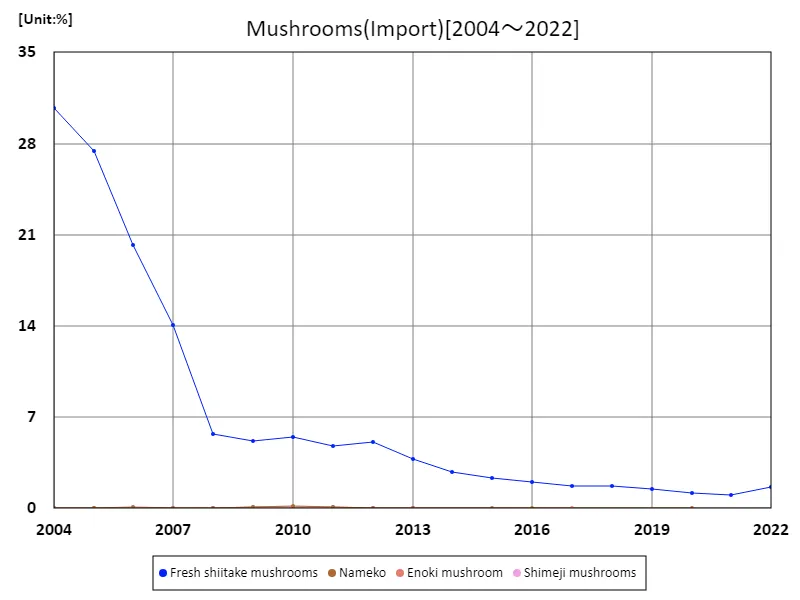Abstract
An interesting overview of vegetable production and imports in Japanese agriculture. According to data from 2022, enoki mushrooms alone have the highest production volume among domestically grown vegetables, reaching 54.8 kt. On the other hand, the main imported vegetable is fresh shiitake mushroom, with an import volume of 423 tons. Fresh shiitake mushrooms account for 1.6% of all imported vegetables. These data reveal the characteristics of mushroom production and imports in Japanese agriculture. While domestically grown enoki mushrooms remain the main product, fresh shiitake mushrooms also occupy a relatively important position among imported vegetables. In addition, since the proportion of fresh shiitake mushrooms among all imported vegetables is relatively low, it is possible that imports of other vegetables are also becoming more diversified. Based on past trends, only domestically produced enoki mushrooms have maintained stable production volumes, while the amount of fresh shiitake mushrooms imported as imported vegetables may be on the rise. In addition, since the proportion of fresh shiitake mushrooms among all imported vegetables is low, it is possible that demand for other imported vegetables is relatively high.
Domestic production of mushrooms
Looking at domestic mushroom production data for Japanese agriculture from 2004 to 2022, some interesting features become apparent. At its peak in 2010, production of Enoki mushrooms reached 89.2kt, but has now fallen to 61.4% of that peak. One characteristic of this period is that enoki mushrooms were the only mushrooms that occupied an important position among Japan’s mushrooms, as can be seen from their high production volumes at their peak. However, the downward trend since its peak may be due to a variety of factors, including changes in the agricultural environment and demand. In addition, the large fluctuations in production volume of just one mushroom species, Enoki mushroom, suggest that the trend is more pronounced compared to other mushroom species. This could be due to farmers adjusting mushroom varieties in response to agricultural diversification and changing demand. In general, it can be seen that domestic mushroom production in Japanese agriculture fluctuates greatly, with the fluctuations being particularly notable in the production volume of Enoki mushrooms. This trend suggests that producers are adapting flexibly to changing agricultural conditions and demands.


The maximum is 89.2kt[2010] of Enoki mushroom, and the current value is about 61.4%
Import quantity of mushrooms
According to the latest 2022 data on Japan’s agricultural vegetable imports, the largest overall was 17.3kt of fresh shiitake mushrooms, which is the current maximum. There are several characteristics and trends that can be seen from this data. First, we can see that fresh shiitake mushrooms occupy the most important position among imported vegetables. This may be due to fresh shiitake mushrooms being a popular ingredient for Japanese consumers. Furthermore, fresh shiitake mushrooms have the highest value in the imported vegetable market, suggesting that they are in higher demand compared to other vegetables. The reasons behind this are thought to be the use of fresh shiitake mushrooms in a variety of dishes and increased demand due to growing health consciousness. This trend suggests that demand for fresh shiitake mushrooms remains stable and high in Japan’s vegetable import market. Additionally, compared to the import volume and demand for other vegetables, it is shown that fresh shiitake mushrooms are particularly noteworthy.


The maximum is 17.3kt[2004] of Fresh shiitake mushrooms, and the current value is about 2.44%
Import (proportion) quantity of mushrooms
Data on the proportion of mushroom imports in Japan’s agriculture reveals some interesting features. In 2004, fresh shiitake mushrooms recorded the highest proportion of imported mushrooms, reaching 30.7%, but since that peak, it has now fallen to 5.21%. There are several characteristics and trends that can be gleaned from this data. First, it is noteworthy that the proportion of fresh shiitake mushrooms imported has dropped significantly since its peak in 2004. This may be due to an increase in imports of other mushrooms. It is possible that the market share that fresh shiitake held at its peak has declined due to competition from other mushrooms and changing consumer preferences. Additionally, as can be seen from 2004 data, fresh shiitake mushrooms have occupied an important position in Japan’s mushroom import market in the past. However, the decline in the percentage over subsequent years suggests that imports of other mushrooms are increasing and the market is becoming more diversified. Overall, the data on the import ratio of mushrooms in Japan’s agricultural sector suggests a trend toward a decrease in imports of fresh shiitake mushrooms and an increase in imports of other mushrooms. This is seen as a response to changes in market demand and supply.


The maximum is 30.7%[2004] of Fresh shiitake mushrooms, and the current value is about 5.21%



Comments